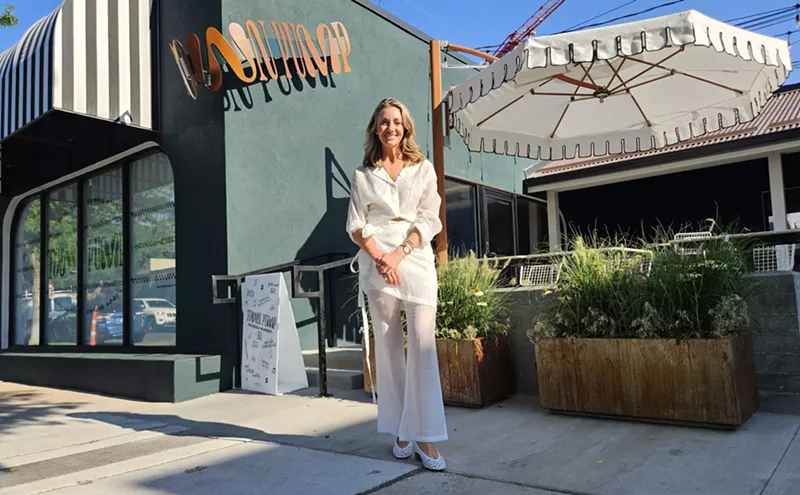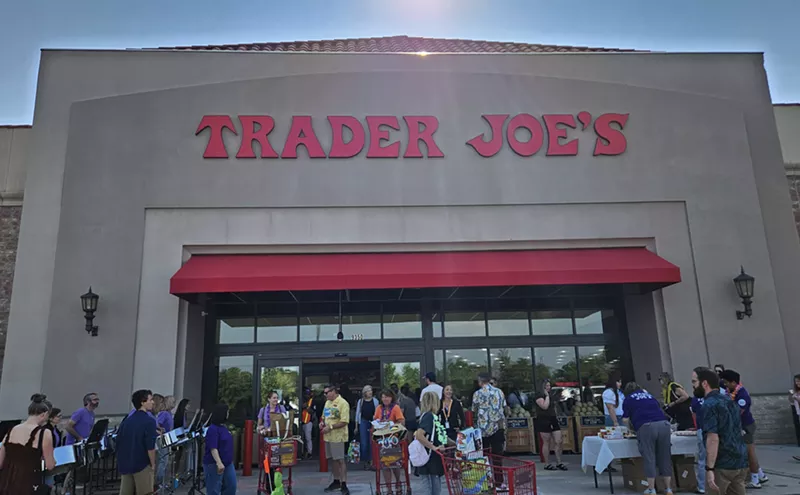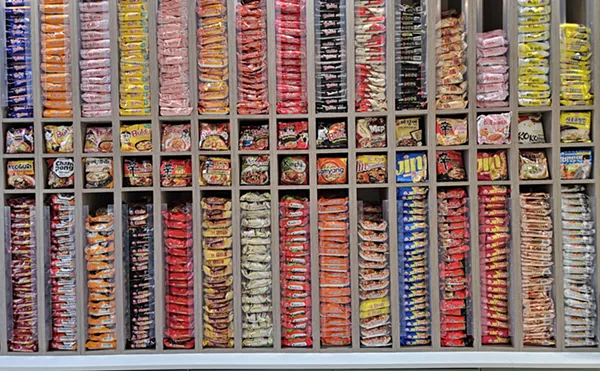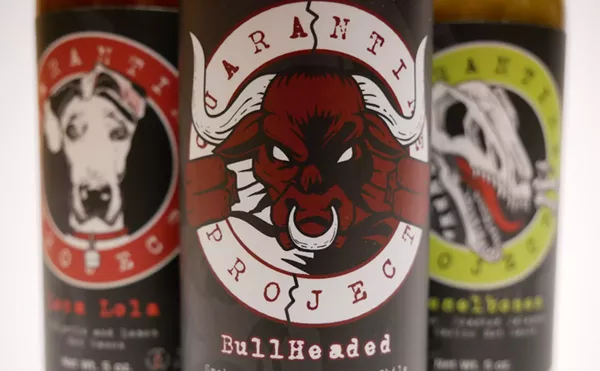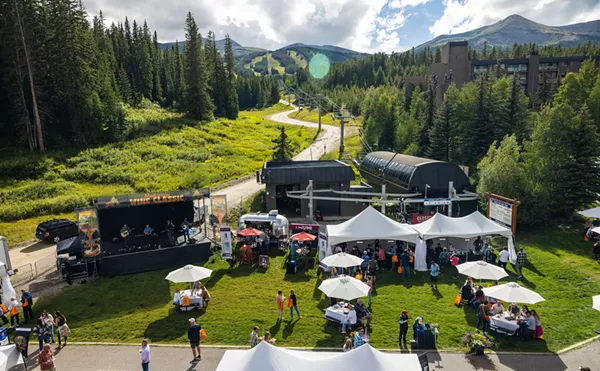If more restaurateurs understood what they were trying to do--and why--there would be more good restaurants out there. Instead, all too many restaurateurs cook up some half-baked "concept," then proceed to force-feed it to customers. Exhibits A through Z: the Olive Garden. This national chain recently announced that it would be using Denver as a test market for a new dining-room design, one that Olive Garden executive types believe will seem more "Italian." In order to create this illusion, they're going to redo all the local Olive Gardens--of which there are too many--with black-and-white photos of alleged Italian life, oversized jars of olives and pickled vegetables, and booths covered with fruit-themed fabric.
Apparently it hasn't occurred to them to make the Olive Garden's recipes more "Italian."
The Olive Garden execs chose Denver as their test site because this market is one of their biggest. That's sad--and scary. It means people here are going to the Olive Garden for pseudo-Italian cuisine in pseudo-Italian surroundings instead of going to, say, Barolo Grill for an authentic taste of Italy. Barolo Grill, whose chef has actually been to Italy and whose staff has actually been to Italy. And whose owner is in Italy right now.
What Blair Taylor is doing in Florence, he won't say. But he's been to Italy many times before, and he's famous within the local restaurant industry--and with national food writers--for taking his entire staff to Toscana and Piemonte (that's Tuscany and Piedmont, for all you Olive Garden lovers) every year for two weeks. There they track down eighty-year-old women who've never seen a television and who spend every moment of their lives creating artisan loaves of bread that taste as earthy as olive trees smell--women who teach Barolo employees how to do the same.
They travel together and they work together. Anyone hired by Barolo has to adopt the schedule shared by all of the employees: Everyone--all eight waiters, seven chefs and two bakers (and, except when he's in Italy, Taylor himself)--must work the five nights a week that Barolo is open for dinner (Tuesday through Saturday; the restaurant doesn't do lunch) and must take their vacations in late June/early July. And they must take their vacations in Italy. They pay for their airfare, and Taylor pays for the accommodations and all the wine and food they care to sample. (Employees also get ten days off when Barolo shuts down at Christmas.)
"Really, when people apply for a job here, they almost always sign off on that agreement," says Taylor, who opened Barolo in 1992 and started the Italian trips two years later. "I only hire one new staff person a year, if that, and so far the arrangement has worked amazingly well."
Taylor is a self-described perfectionist, and the trips to Italy are but a part of his overall design for duplicating the feel, the textures, the foods and the wines from that country--as authentic a duplication as possible, rather than some marketing genius's idea of what "Italian" should be. And Taylor manages to pull it off, with substance and style. Barolo's cuisine is as Northern Italian as it can be short of coming straight from a kitchen in Pienza--which means that sometimes it's breathtakingly complex, and sometimes it's so simple and austere that it seems like a joke. But that's the beauty of food from these regions, where the best of everything is grown and cultivated, revered and appreciated. And Barolo's staff clearly buys into the same philosophy.
In addition to being passionate about Italian food, Taylor is also an oenophile of epic proportions, giving particular emphasis to those wines from Tuscany and Piedmont. But he doesn't take it to the snob level, as evidenced by the categories in Barolo's 480-bottle wine list (which, by the way, has been lauded in every major food magazine): "Really Fun Wines at $15," "Really, Really Fun Wines at $18," and "Really Special Wines" that range from $26 to $42. And then there's the "Very Powerful Wine List," which offers such gems as the oak-aged terre di tufo from Teruzzi e Puthod and Badia a Coltubuono's 1990 sangioveto, pricey and nearly impossible to find. It probably helps that Taylor just started his own wine-importing business, Enotec Imports.
And it certainly helps that the staff is so knowledgeable about the wines. They know how to talk about them, how to recommend them and how to pour them. We were aware that the Castello Banfi brunello di montalcino we'd ordered was a good deal, but also that it was going to be pretty tight until it breathed for a while--and our server recognized it, too. He kept smelling the wine and doling out small amounts so we could track its progress, and when it did finally open up--midway through our second course--he shared our joy.
He was a little too confident about the rest of our meal, though. Despite the kitchen's dazzling way with food, not everything we tried was perfect. Still, so much of it was sublime that we found it easy to forgive Barolo's transgressions.
I had gone with the Piemontese dinner ($39.95), a five-course, prix-fixe menu that started with bresaola: aged dried beef thinly sliced and adorned with shaved parmigiano-reggiano and a fine drizzle of white truffle oil--so spartan, but so satisfyingly plush. While I inhaled my next course, the seafood terrine, a delectable little cake layered with smoked salmon, Yukon gold potatoes and leeks, my husband picked at the insalata di mare ($7.95). The squid was surprisingly bland, and the red onions and baby mache--the tangy, nutty green that was known as corn salad until it became hip--did nothing to help. As consolation, I let him share my risotto course, a rich, rich dish of Arborio rice with apples, walnuts and gorgonzola, one of my all-time favorite cheeses.
We also weren't thrilled with my husband's gnocchi di cignale ($16.50): The wild-boar-enhanced bolognese sauce sounded more exciting than it tasted, and while the potato dumplings had an ideal consistency--soft and supple--the sauce was a bit too thick, which made the dish seem dry overall. My veal porterhouse was also rather dry and chewy--information I later shared with our server, who'd come by before I'd even had a chance to stick a knife into it and inquired, "How wonderful is it?" But the sauce on the veal, a concentrated green-peppercorn blend, was very smart, and so was the accompanying caramelized fennel and pine-nut salad, filled with competing and complementary flavors.
Our know-it-all server seemed genuinely downcast that we hadn't loved our entrees. Fortunately, when he asked how wonderful our desserts were, we were able to answer more positively. In fact, the fallen chocolate souffle ($5.45) and the sweet cheese tart ($5.45) were superb.
A less cocksure server took care of us on our second visit, but this time the food was irreproachable. We started with the animelle alla griglia ($8.50), sweetbreads in a mildly rich amaretto cream sauce, and the fritto misto appetizer ($8.25), a sampler of fried shrimp, calamari and scallops served with a refined harissa mayonnaise (harissa is a Middle Eastern sauce usually made of chiles, garlic, cumin and caraway). According to Taylor, the fritto misto is one of the menu's only three constants.
Another is the Barolo duckling ($18.95), a consistent stunner. The bird had been simmered in Barolo wine, a lush, robust and assertive red that brought out the sweetness of the duck rather than doing it in; kalamata olives provided an extra--and welcome--tang. And the accompanying garlicky, rosemary-scented potatoes were alternately crispy and soft in all the right places. More kalamatas enlivened the tuna puttanesca ($13.95), rare ahi seared and then paired with linguine in a sweet-and-spicy sauce that used roasted peppers to balance out the fiery chiles.
The third item that Barolo always offers is the creme brulee ($5.45). This classic version boasted vanilla-heavy custard beneath a thin shell of caramelized sugar; it had just the right sweetness, just the right texture. And the Arborio rice pudding ($5.45) was as comforting as a heating pad, the creamy rice dressed up with nutmeg and apricots almost the color of Barolo's walls.
Bare of everything but color and vineyard vines, those walls cradle diners in comfortable intimacy. A fireplace glows to one side, and the entire dining room is filled with warmth. It doesn't need a photograph labeled "authentic upscale Tuscan farmhouse" to feel like an upscale Tuscan farmhouse.
One that serves authentic Italian food. What a concept.
Barolo Grill, 3030 East Sixth Avenue, 393-1040. Hours: 5:30-10 p.m. Tuesday-Saturday.




